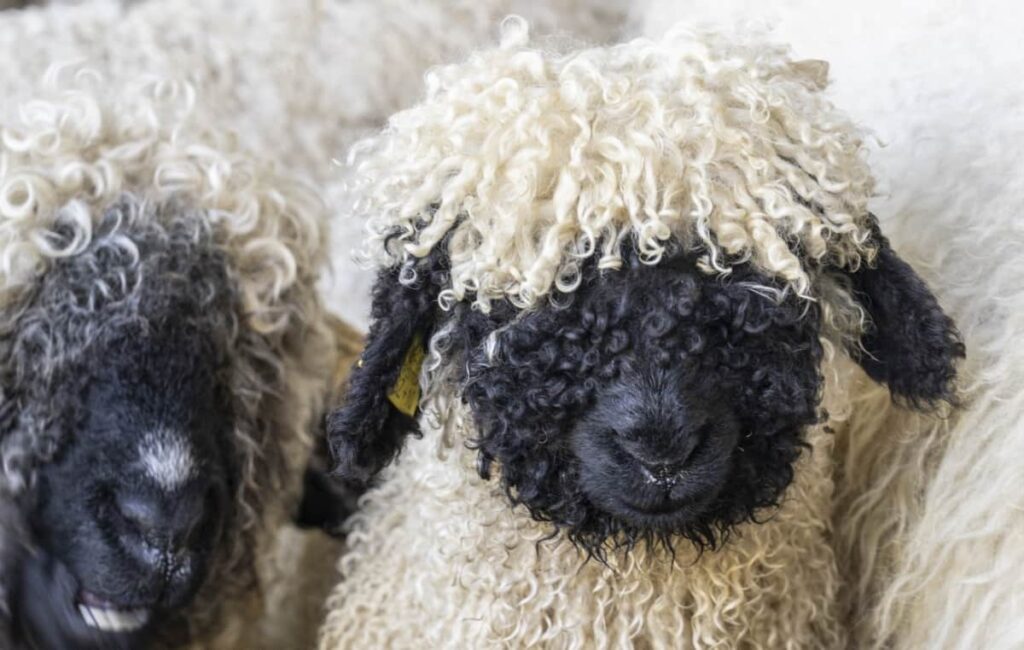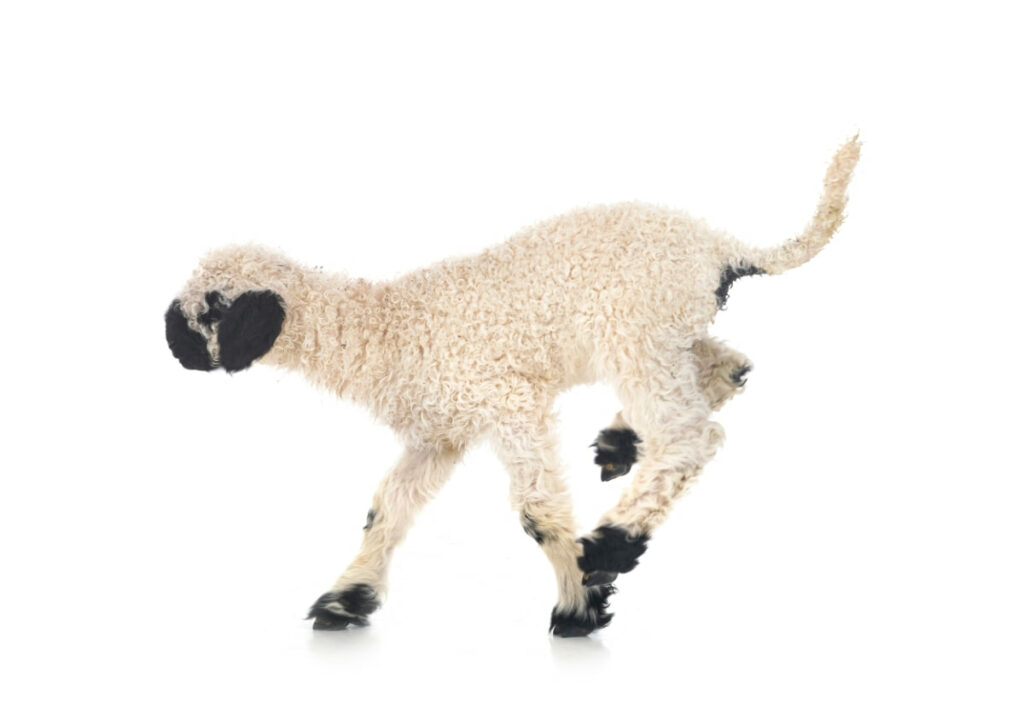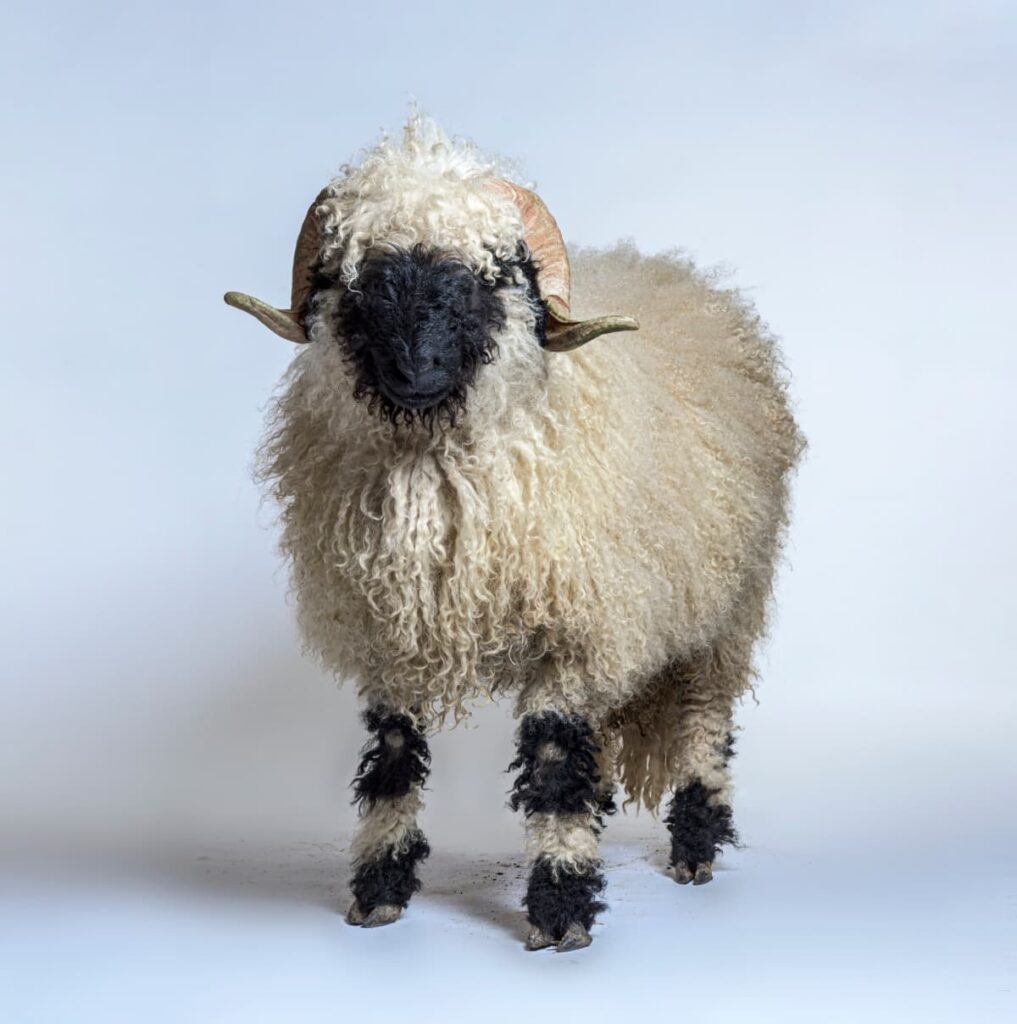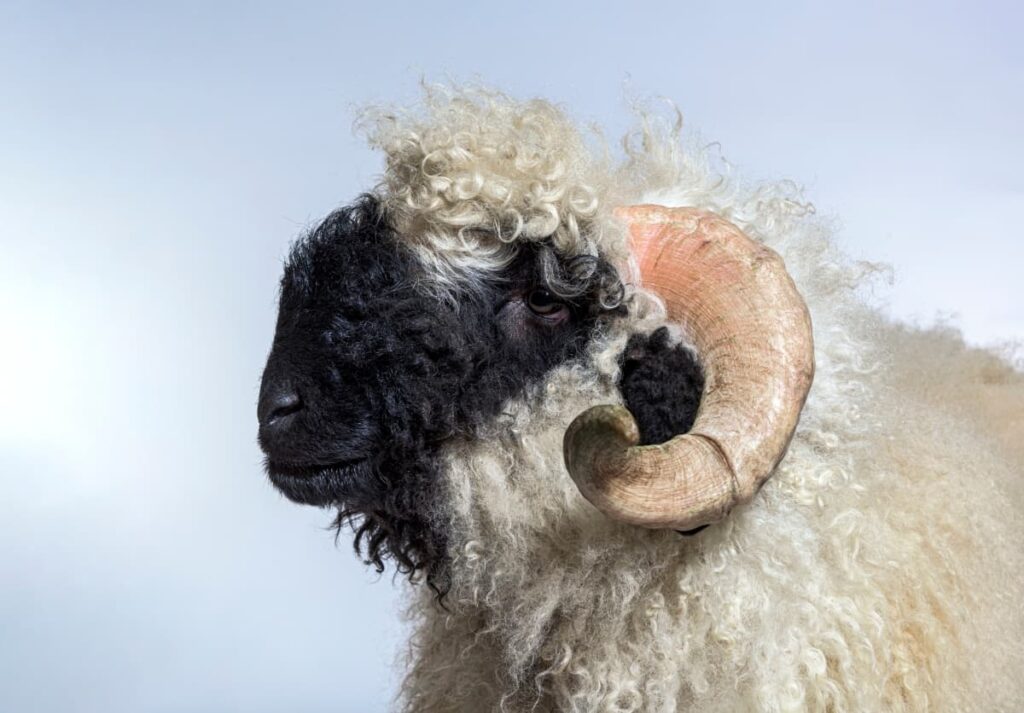The Valais Blacknose sheep, also known as Walliser Schwarznasenschaf in German, is a remarkable breed of domestic sheep hailing from the stunning Valais region of Switzerland. With their distinctive black face and legs contrasted against their fluffy white wool, they are instantly recognizable. The Valais Blacknose sheep hold a significant importance in the world of agriculture and animal husbandry.

All You Need to Know About Valais Blacknose Sheep
Historical Background
These charming sheep were traditionally kept on steep mountain slopes where other livestock struggled to survive. Their ability to adapt and thrive in such harsh conditions made them highly valued by shepherds as both meat and wool producers. Over time, this breed became an integral part of Swiss agriculture and culture.
Valais Blacknose Price
These adorable creatures are considered quite luxurious in the world of sheep breeding. The cost can change based on factors like age, gender, pedigree, and overall quality. The demand for these rare and unique animals has driven up their price significantly. On average, the cost of Valais Blacknose sheep is anywhere from $1,500 to $9,000 per ewe (female) or ram (male). And if you’re looking for top-quality breeding stock or show-quality specimens, be prepared to shell out even more.
Valais Blacknose Lifespan
When properly cared for, Valais Blacknose sheep’s lifespan is up to 10-12 years on average. With good nutrition and regular veterinary care, these amazing animals can enjoy a long and healthy life alongside their human companions.
Valais Blacknose Uses
They are primarily raised for both meat production – known for their superb flavor – as well as wool production, which yields soft fibers that are highly sought after by crafters around the world.
Physical Characteristics
Description of Appearance
The Valais Blacknose sheep is truly a sight to behold with its distinct and captivating appearance. These majestic creatures have a large body covered in dense, curly wool that gives them a fluffy and cuddly appearance. Their faces are adorned with a black nose, hence their name.
Unique Features
The unique feature of the Valais Blacknose sheep is their striking horns. Both males and females possess these impressive spiral-shaped horns that add to their overall charm. The size and shape of the horns can vary from individual to individual, making each one even more special.
In terms of size, Valais Blacknose sheep are considered medium-sized animals. Males typically weigh between 80-130 kg (180-290 lb), while females weigh around 70-90 kg (150-200 lb). Despite their robust build, these sheep move with gracefulness and elegance. Their wool is another distinguishing characteristic that sets them apart from other breeds.
Geographical Origin and Habitat
Origin of the Breed
The Valais Blacknose sheep breed hails from the picturesque region of Valais in Switzerland. Nestled amidst the majestic Swiss Alps, this breed has adapted to thrive in its mountainous surroundings. The harsh climate has shaped their physical characteristics and resilience. Originating in the 15th century, these sheep were initially bred for their wool, which was highly sought after for making warm garments to withstand the cold alpine winters. Over time, they became popular not only for their wool but also for their delicious meat.
Natural Habitat and Distribution
These beautiful creatures are primarily found in Switzerland but have popularity worldwide due to their unique appearance and gentle temperament. While they may be seen roaming freely across meadows during warmer months, they require adequate shelter during winter when temperatures plummet.
In case you missed it: Biellese Sheep: A Comprehensive Guide to Raising, Care, Wool, and Breeding

Behavior and Temperament
Social Behavior
Valais Blacknose sheep are known for their friendly and docile nature. They have strong social behavior, often forming close bonds with their flock mates. These sheep enjoy being in the company of others, both humans and animals alike.
Interaction with Humans
Valais Blacknose sheep are gentle and curious creatures. They often approach people without hesitation, especially if they have been raised in a positive and nurturing environment. Due to their friendly nature, Valais Blacknose sheep can be easily trained and handled. They respond well to gentle handling techniques and can quickly learn basic commands if properly taught.
Breeding and Genetics
Breeding Practices
Breeding Valais Blacknose sheep requires careful planning and consideration of various factors. Breeders aim to produce healthy, strong lambs with all the desirable characteristics that make this breed so unique. This involves selecting suitable breeding pairs based on their genetic traits. Breeders carefully analyze the genetics of each sheep before making breeding decisions. This helps maintain the overall health and vitality of the breed.
Genetic Traits and Diversity
When selecting breeding pairs, breeders look for specific traits such as good conformation, strong wool quality, and characteristic black markings on the face and legs. Through strategic breeding practices, breeders can enhance certain qualities while minimizing any potential weaknesses or undesirable traits within future generations of Valais Blacknose sheep.
By prioritizing genetic diversity in their breeding programs, breeders contribute to the long-term sustainability of this rare breed. Maintaining a wide range of genetic variation ensures that Valais Blacknose sheep remain resilient against diseases and environmental challenges.
Husbandry Practices
Feeding and Nutrition
Feeding Valais Blacknose sheep involves providing them with a good diet consisting of high-quality hay, fresh grass, and a variety of minerals. They are grazers by nature, so access to pasture is essential for their natural grazing behavior.
Shelter and Space Requirements
Shelter is another important aspect of husbandry practices for Valais Blacknose sheep. These sheep thrive in cooler climates but can adapt well to various weather conditions. However, they do need adequate protection from extreme temperatures and inclement weather. Space requirements for Valais Blacknose sheep depend on the size of your flock. Each adult sheep requires approximately 12-16 square feet of space in an enclosed area or paddock.
Health and Welfare
Common Health Issues
Valais Blacknose sheep are generally hardy animals, but like any breed, they may be susceptible to certain health issues. One common health issue that can affect Valais Blacknose sheep is foot rot. This bacterial infection can cause lameness and discomfort in affected individuals.
Regular hoof trimming and keeping the pasture clean and dry can help prevent this condition. Another concern for Valais Blacknose sheep is parasites, such as worms. These pesky creatures can lead to weight loss, anemia, and even death if left untreated. Regular deworming protocols recommended by a veterinarian should be followed to keep parasites under control.
Welfare Considerations and Veterinary Care
Providing appropriate shelter and space is essential for the welfare of Valais Blacknose sheep. They need access to a well-ventilated barn or shed during extreme weather conditions. Ample space for exercise is also crucial to ensure their physical well-being. Regular veterinary inspections are important to monitor the overall sheep’s health. Vaccinations against common diseases should be administered according to a veterinarian’s recommendations. Additionally, routine dental care, including teeth floating if needed, ensures proper chewing and digestion.
In case you missed it: Shetland Sheep Breed: History, Characteristics, Price, Size, Breeding and Raising

Economic and Cultural Significance
Role in Agriculture
Valais Blacknose sheep play a crucial role in the agricultural industry, particularly in regions where they are raised. Due to their ability to adapt to various climates, these sheep have become valuable assets for farmers. They are known for their excellent meat quality, which makes them highly sought after by consumers.
Cultural and Historical Importance
These majestic creatures have been a part of Swiss farming traditions for centuries, symbolizing resilience and strength. Their distinctive appearance has also made them popular subjects of folklore and art. Their presence at local festivals and competitions further highlights their cultural significance as they showcase the rich heritage of rural communities. These sheep serve as a reminder of our deep connection with nature and agriculture. By raising and preserving this breed, we contribute to the preservation of traditional ways that have shaped our history.
Conservation and Sustainable Practices
Conservation Status
The conservation status of Valais Blacknose sheep is currently classified as “vulnerable” by various agricultural organizations due to their limited population. This designation highlights the importance of protecting and safeguarding these animals from extinction.
Efforts for Sustainable Breeding
Efforts for sustainable breeding have been implemented to ensure the long-term survival of Valais Blacknose sheep. Breeders follow strict guidelines to maintain genetic diversity within the population while prioritizing health and well-being. By carefully selecting breeding pairs based on desired traits, such as conformation or wool quality, breeders aim to enhance the overall characteristics of this remarkable breed.
In case you missed it: Hampshire Sheep Breed: Characteristics, Origin, Size, Weight, Price, Lifespan, and Disadvantages

Conclusion
Raising Valais Blacknose sheep comes with a multitude of benefits that make them an attractive choice for farmers and livestock enthusiasts alike. The key advantage is their dual-purpose nature, as they are raised both for meat and wool production. These sheep have excellent maternal instincts and fertility rates, making them efficient breeders.
- Profitable Village Farming Business Ideas in 2024
- High-Yield Aquaculture: Fast-Growing Fish for Farming
- Effective Fish Pond Construction Techniques for Beginners
- Irrigation and Water Management in Pineapple Farming
- Blossom to Harvest: Mastering Flowering and Pollination in Papaya Farming
- Pig Fattening Essentials: From Selection to Sale for Beginners
- Raising Wagyu Cattle: A Complete Guide for Premium Beef Production
- Soil Types and Their Water Holding Capacity
- Optimizing Irrigation Schedules for Coconut Groves for Enhanced Yield
